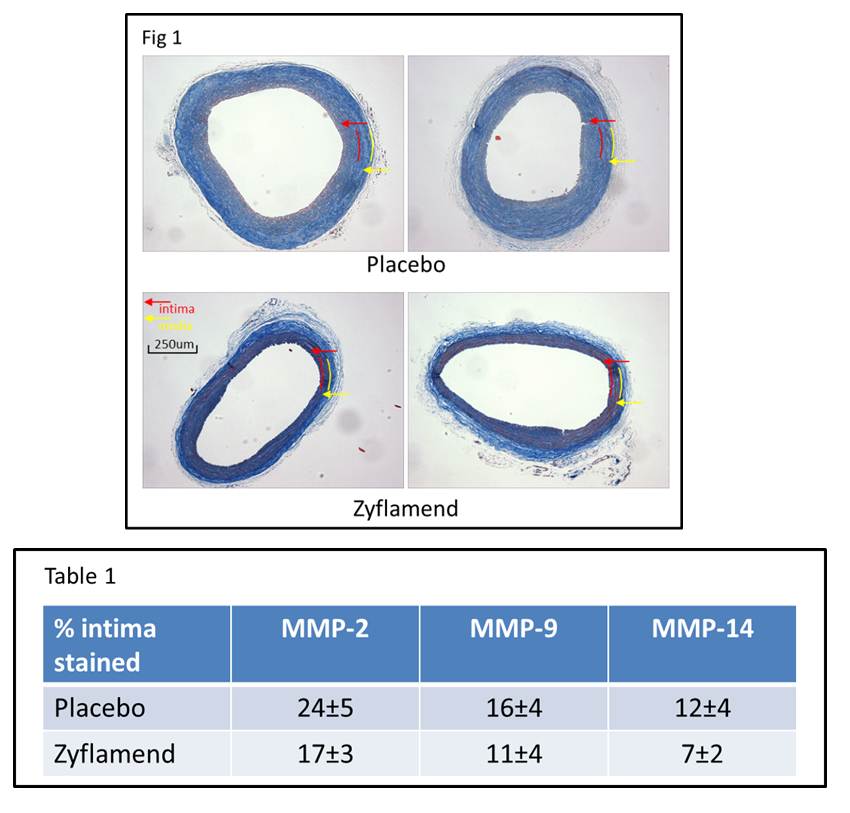Back to 2015 Annual Meeting Posters
A Poly-Herbal Dietary Supplement, Zyflamend, Inhibits Matrix Metalloproteinase Expression and Attenuates Intimal Hyperplasia in a Rodent Model of Vascular Disease
Lindsay M Bools1, Ryan M Buckley1, Deidra JH Mountain1, Stacy S Kirkpatrick1, Jay Whelan2, Paul D Terry3, Mitchell H Goldman1, Michael B Freeman1, Oscar H Grandas1
1University of Tennessee Graduate School of Medicine, Knoxville, TN;2University of Tennessee, Department of Nutrition, Knoxville, TN;3University of Tennessee, Department of Public Health, Knoxville, TN
Introduction: It is well established that peripheral vascular disease and atherosclerosis are pro-inflammatory modulated disease processes. Previous studies from our laboratory have focused on identifying and defining the role of inflammatory mechanisms, matrix remodeling enzymes, and sex hormone exposure in intimal hyperplasia (IH) and restenosis. Zyflamend is a poly-herbal dietary supplement that has been previously shown to have potent anti-inflammatory properties, inhibit cell cycle progression and proliferation, reduce androgen receptor expression, and attenuate inflammatory-modulated pathologies such as tumor progression. Here we examined the effect of Zyflamend on inflammatory-dependent vascular remodeling mechanisms and in the prevention of IH in an animal model of vascular disease.
Methods: The diets of aged male rats were supplemented with human equivalent doses of Zyflamend or placebo for 7d prior to balloon angioplasty-induced injury of the right carotid artery and continuously thereafter for the duration of the study. Carotid tissue was collected 28d post-injury, stained with trichrome elastin for intima:media (I:M) quantification, and with isoform-specific antibodies for matrix metalloproteinase (MMP) quantification. Serum was collected pre- and post-supplementation and at sacrifice for cytokine analysis via qualitative antibody array and quantitative multiplex array.
Results: I:M was decreased in Zyflamend animals compared to placebo controls (0.50±0.07 vs. 0.69±0.07, n=5, P<0.05, Fig 1). Matrix remodeling enzymes were downregulated in the tissue of Zyflamend animals compared to placebo controls (Table 1). Preliminary qualitative cytokine screening indicate injury-induced interleukin family isoforms, interferon-γ, intercellular adhesion molecule, and tumor necrosis factor-α may be downregulated by Zyflamend supplementation. Quantitative analysis is ongoing.
Conclusion: Dietary supplementation with Zyflamend decreases IH development in vivo, possibly via MMP regulatory mechanisms under the control of inflammatory signaling cascades. To our knowledge this is the first study to investigate the potential for this poly-herbal mixture to modulate vascular pathogenesis. Ongoing studies are evaluating these processes in a larger animal population. Future studies will investigate Zyflamend’s effect on hormonally regulated intimal hyperplasia. Our long-term objective is for this pilot animal study to serve as the backbone for a clinical trial investigating the potential for Zyflamend as a therapeutic anti-inflammatory agent in the prevention of vascular disease progression.

Back to 2015 Annual Meeting Posters
